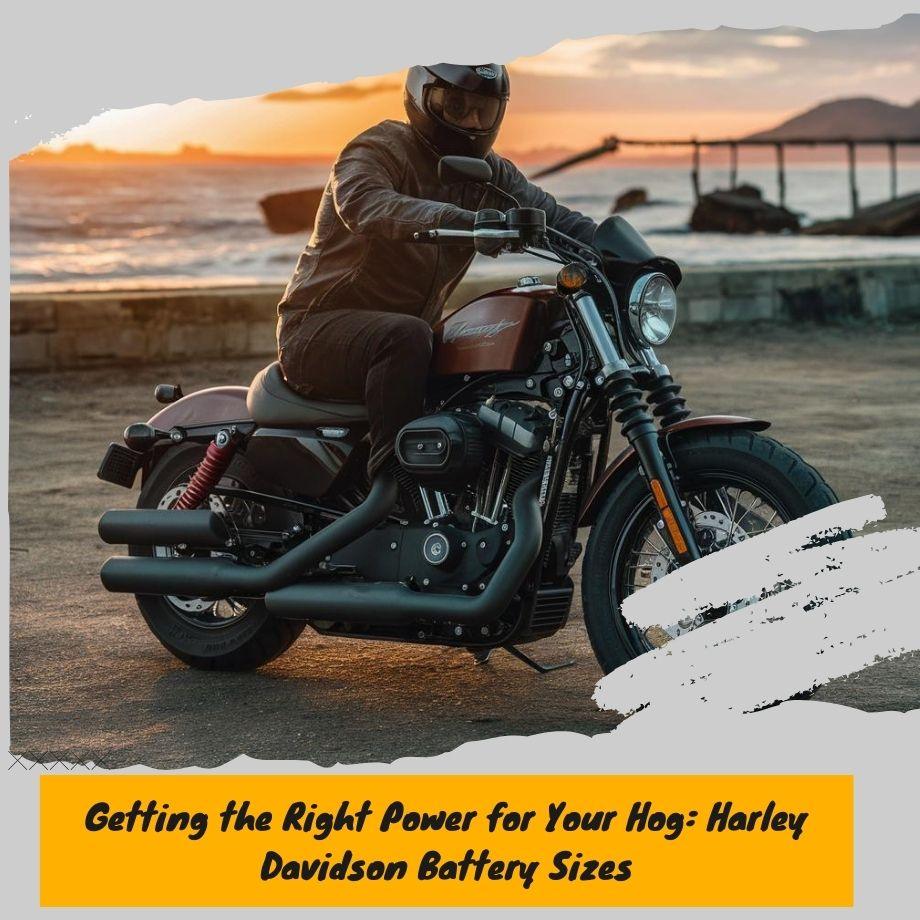What Battery Fits Your Harley? Our Handy Size Chart Has the Answers

Batteries play a crucial role in the performance and reliability of Harley-Davidson motorcycles.
These iconic bikes are known for their powerful engines and distinctive rumble, but without a properly sized and functioning battery, even the mightiest V-twin would fail to roar to life.
Harley-Davidson batteries are responsible for providing the essential electrical power required to start the engine, power the lights, and operate various electronic components and accessories.
A weak or improperly sized battery can lead to starting issues, dimming lights, and potential electrical system failures, which can significantly impact your riding experience and safety on the road.
Furthermore, Harley-Davidson motorcycles are designed with specific battery compartments and mounting systems, making it essential to choose the correct battery size and dimensions.
An ill-fitting battery can cause damage to the battery tray, electrical connections, or even the frame itself, potentially leading to costly repairs and compromised performance.
Mocardine is marking the riding season with fantastic discounts on Harley Tour Packs! Whether you’re embarking on a coast-to-coast adventure or need more room for everyday rides, now is the ideal time to elevate your bike with a high-quality Tour Pack.
Understanding Battery Group Sizes for Harley-Davidson
Battery group sizes are standardized designations used to categorize lead-acid batteries based on their physical dimensions and terminal configurations. These group sizes help ensure compatibility between batteries and the vehicles or equipment they power.
For Harley-Davidson motorcycles, several common battery group sizes are widely used, each designed to meet the specific power demands and fitment requirements of different models.
The most prevalent battery group sizes found in Harley-Davidson motorcycles include:
**BT9A/BT9A-BS**: This is a popular size for many Harley models, including the Sportster, Dyna, and certain Softail models. It offers a balance of compact dimensions and sufficient cranking power for reliable starting performance.
**BT12A/BT12A-BS**: Utilized in larger Harley-Davidson models like the Touring and Trike lines, the BT12A provides increased capacity and reserve power to handle the electrical demands of these bikes, ensuring reliable starts and supporting additional accessories.
**BT14A/BT14A-BS**: This larger battery group size is often found in Harley-Davidson's heavyweight touring models, such as the Road King and Electra Glide. It offers enhanced cranking power and reserve capacity to accommodate the electrical needs of these bikes, including their advanced electronics and lighting systems.
Harley-Davidson Battery Size Chart
When it comes to ensuring your Harley-Davidson motorcycle runs smoothly, having the right battery is crucial. The battery not only provides the necessary power to start your engine but also plays a vital role in powering various electrical components.
To help you find the perfect battery for your beloved Harley, we've compiled a comprehensive chart listing various models and their corresponding battery group sizes.
This chart includes details such as voltage and amp-hour ratings, ensuring you have all the information you need to make an informed decision.
Whether you're a seasoned rider or a newcomer to the world of Harley-Davidson, this guide will simplify the process of selecting the right battery for your bike.
| Model | Year | Battery Group Size | Voltage | Amp-Hour Rating |
|---|---|---|---|---|
| Sportster | Various | BT9A/BT9A-BS | 12V | 12 Ah |
| Dyna | Various | BT9A/BT9A-BS | 12V | 12 Ah |
| Softail | Various | BT9A/BT9A-BS | 12V | 12 Ah |
| Touring | Various | BT12A/BT12A-BS | 12V | 18 Ah |
| Trike | Various | BT12A/BT12A-BS | 12V | 18 Ah |
| Road King | Various | BT14A/BT14A-BS | 12V | 21 Ah |
| Electra Glide | Various | BT14A/BT14A-BS | 12V | 21 Ah |
It's important to note that while this chart covers a wide range of Harley-Davidson models, it's always recommended to cross-check the specifications with your owner's manual or consult with a certified Harley-Davidson technician.
Proper battery installation and maintenance are crucial for ensuring optimal performance and longevity.
With this comprehensive battery size chart at your fingertips, you can confidently navigate the world of Harley-Davidson batteries, ensuring your ride remains reliable and powerful for years to come.
Factors Influencing Harley-Davidson Battery Size
When it comes to choosing the right battery size for your Harley-Davidson motorcycle, several factors come into play. Understanding these factors can help you make an informed decision and ensure optimal performance and longevity for your beloved ride.
Engine Displacement
The engine displacement of your Harley plays a significant role in determining the battery size required. Larger engines generally demand more power from the battery, especially during startup.
As a result, bikes with bigger displacement engines, like the iconic Milwaukee-Eight or Twin Cam models, may require a larger battery to provide the necessary cranking amps.
Electrical Accessories
Modern Harley-Davidson motorcycles often come equipped with a wide range of electrical accessories, such as heated grips, GPS systems, audio systems, and additional lighting.
Each of these accessories draws power from the battery, increasing the overall electrical load. If you plan to add aftermarket accessories or have a heavily accessorized bike, opting for a larger battery can help ensure sufficient power delivery and prevent premature battery drainage.
Riding Conditions
The riding conditions you typically encounter can also influence your battery size choice. If you frequently ride in cold weather or live in a region with extreme temperatures, a larger battery may be beneficial.
Cold temperatures can significantly reduce a battery's cranking power, making it harder to start the engine. A larger battery can provide the extra cranking amps needed in these challenging conditions.
Additionally, if you plan to undertake long-distance touring or frequent short trips, a larger battery can better handle the increased electrical demands and provide peace of mind against unexpected battery issues on the road.
Common Indicators of a Failing or Weak Battery in a Harley-Davidson Motorcycle
As a Harley-Davidson owner, being aware of the signs of a failing or weak battery is crucial to ensure your motorcycle's reliable performance and prevent unexpected breakdowns.
One of the most common indicators is difficulty starting the engine, especially in colder weather or after the motorcycle has been sitting for an extended period. If you find yourself having to crank the engine multiple times or notice a sluggish starter motor, it could be a sign that your battery is losing its ability to provide the necessary power.
Another telltale sign is dimming headlights or other electrical components. When the battery is weak, it may struggle to supply sufficient voltage to power all the electrical systems, leading to dimmed or flickering lights, a sluggish instrument cluster, or even intermittent operation of accessories like heated grips or a stereo system.
If you notice a sulfuric or rotten egg-like smell coming from the battery compartment, it could indicate that the battery is overheating or has experienced internal damage, potentially leading to leakage or swelling.
This is a serious issue that requires immediate attention to prevent further damage to your motorcycle's electrical system or potential safety hazards.
Timely replacement of a failing or weak battery is crucial for several reasons.
First and foremost, it ensures reliable starting and operation of your Harley-Davidson motorcycle, preventing frustrating breakdowns and potential safety hazards.
Additionally, a weak battery can put extra strain on the charging system, potentially leading to premature failure of other electrical components like the alternator or voltage regulator.
Best Practices for Installing and Maintaining Harley-Davidson Batteries
Proper installation and maintenance are crucial for ensuring your Harley-Davidson battery operates at peak performance and has a long lifespan. Here are some best practices to follow:
- Cable Connections: Ensure the battery cables are securely connected to the terminals. Loose connections can cause electrical issues, drainage, and even damage to the battery or electrical components. Clean the cable connectors and battery terminals regularly to prevent corrosion buildup.
- Ventilation: Batteries release hydrogen gas during charging and operation, so adequate ventilation is essential. Never charge or operate your battery in an enclosed space without proper airflow, as the accumulated gases can become explosive.
- Charging Procedures: Follow the manufacturer's recommendations for charging your specific battery type. Overcharging or undercharging can shorten the battery's life or cause permanent damage. Use a quality battery charger designed for your battery's specifications, and follow the charging instructions carefully.
- Maintenance Schedule: Adhere to the recommended maintenance schedule for your Harley-Davidson battery. This typically includes regular cleaning, checking the electrolyte levels (for lead-acid batteries), and load testing to ensure the battery is holding a proper charge.
- Storage: If you plan to store your Harley-Davidson for an extended period, remove the battery and store it in a cool, dry place. Batteries can self-discharge over time, so it's essential to charge them periodically during storage to maintain their condition.
Guidance on Selecting High-Quality Batteries for Harley-Davidson
Lead-acid batteries have been the traditional choice for motorcycles, offering a cost-effective and proven solution.
However, they require more maintenance, such as periodic electrolyte level checks and potential acid spills during charging or installation. Newer technologies like Absorbed Glass Mat (AGM) and lithium-ion batteries offer several advantages over traditional lead-acid batteries.
AGM batteries are a popular choice for Harley-Davidson owners due to their superior vibration resistance, spill-proof design, and low maintenance requirements.
They can deliver higher cranking amps and have a longer service life compared to conventional lead-acid batteries.
Additionally, AGM batteries are more resistant to extreme temperatures and can withstand deeper discharge cycles without compromising performance.
Lithium-ion batteries are the latest innovation in motorcycle battery technology. They offer exceptional cranking power, lightweight construction, and an extended lifespan.
Lithium-ion batteries are also maintenance-free and can withstand extreme temperatures better than lead-acid or AGM batteries. However, they come with a higher price tag and may require specialized charging systems.
When selecting a battery for your Harley-Davidson, it's essential to consider reputable brands known for their quality and reliability.
Trusted manufacturers like Yuasa, Odyssey, and Shorai have earned a solid reputation in the motorcycle industry for producing high-performance batteries specifically designed for Harley-Davidson models.
Important Safety Considerations When Working with Harley-Davidson Batteries
Working with motorcycle batteries, including those used in Harley-Davidson models, requires taking proper safety precautions. These batteries contain sulfuric acid, which can cause severe burns if mishandled.
Always wear protective gear, such as goggles, acid-resistant gloves, and a long-sleeved shirt, when handling or working near the battery.
Ensure adequate ventilation in the work area, as batteries can release explosive hydrogen gas during charging or discharging.
You May Also Like: Advanced Braking Features - RDRS system
Never smoke or create sparks near the battery, as this could ignite the hydrogen gas and cause an explosion.
When removing or installing a battery, disconnect the negative (-) cable first, and reconnect it last to avoid short circuits.
Be cautious not to drop metal tools across the battery terminals, as this can create sparks and potentially cause an explosion or fire.
If acid comes into contact with your skin or eyes, immediately flush the affected area with clean, cool water for at least 15 minutes and seek medical attention.
Neutralize any spilled acid with baking soda and water before cleaning up the area.
Electrical Accessories and Battery Size Requirements
Adding electrical accessories or upgrades to your Harley-Davidson motorcycle can significantly impact your battery size requirements and overall electrical system demands.
As you install more power-hungry components like heated grips, auxiliary lights, or a powerful sound system, the electrical load on your battery increases. This increased demand can lead to premature battery failure or even electrical system issues if not addressed properly.
It's crucial to understand that your motorcycle's stock battery may not be sufficient to handle the additional electrical load from these accessories.
Each component you add draws its own current, and the cumulative effect can quickly overwhelm the battery's capacity. This is especially true for older Harley models or those with smaller batteries.
To ensure your electrical system functions optimally and to prevent any issues, you may need to upgrade to a larger battery with a higher amp-hour rating.
This will provide the necessary reserve capacity to power all your accessories while still maintaining enough charge for starting the engine and running essential systems.
Additionally, you might need to consider upgrading other components of your electrical system, such as installing a higher-output alternator or upgrading the wiring harness to handle the increased current flow.
These upgrades will help ensure that your electrical system can handle the additional load without causing any issues.
It's always recommended to consult with a professional or refer to your motorcycle's service manual to determine the appropriate battery size and electrical system upgrades required for your specific accessory setup.
Proper planning and upgrades will not only ensure reliable performance but also protect your investment in your beloved Harley-Davidson.
Addressing Common Queries and Misconceptions
First and foremost, it's important to understand that Harley-Davidson motorcycles use a variety of battery sizes, and the specific size required can vary based on the model and year of your bike.
While there are some general guidelines, it's always best to consult your owner's manual or a trusted Harley-Davidson dealer to ensure you get the right battery for your specific ride.
One common misconception is that all Harley-Davidson batteries are the same size. This is simply not true.
Over the years, Harley has used different battery sizes and types, ranging from conventional lead-acid batteries to more modern AGM (Absorbed Glass Mat) and lithium-ion batteries. Choosing the wrong size or type can lead to electrical issues, reduced performance, and even potential safety hazards.
Another frequent question revolves around battery maintenance. Many riders assume that because Harley-Davidson batteries are designed for motorcycles, they require little to no maintenance. However, this is not the case.
Like any other battery, Harley batteries need to be properly charged, cleaned, and inspected regularly to ensure optimal performance and longevity. Neglecting battery maintenance can lead to premature failure and potentially costly replacements.
You May Also Like: Average Costs for Basic Customizations
When it comes to battery replacements, some riders may be tempted to opt for cheaper, aftermarket options. While this can save money upfront, it's important to remember that Harley-Davidson batteries are designed and engineered specifically for their motorcycles.
Using a non-OEM (Original Equipment Manufacturer) battery can potentially compromise the electrical system, leading to issues such as dimming lights, starting problems, or even damage to other components.
Finally, there's a common belief that bigger is always better when it comes to motorcycle batteries.
While a larger battery may provide more cranking power and longer run times, it's essential to ensure that it fits properly in your Harley's battery compartment. Forcing a larger battery into a space it wasn't designed for can lead to damage, shorts, and other potential hazards.
Choosing the Right Battery Size: Key to Harley-Davidson's Reliable Performance
Owning a Harley-Davidson motorcycle is a source of pride and passion for many riders. These iconic machines are known for their powerful engines, distinctive rumble, and unmatched style.
However, to ensure your Harley-Davidson runs smoothly and delivers the performance you expect, selecting the correct battery size is crucial. The battery is the heart of your motorcycle's electrical system, providing the necessary power to start the engine, operate the lights, and run various electronic components.
Proper battery maintenance and timely replacements are equally important. A well-maintained battery can extend the life of your Harley-Davidson and prevent costly breakdowns or inconveniences on the road.







Leave a comment